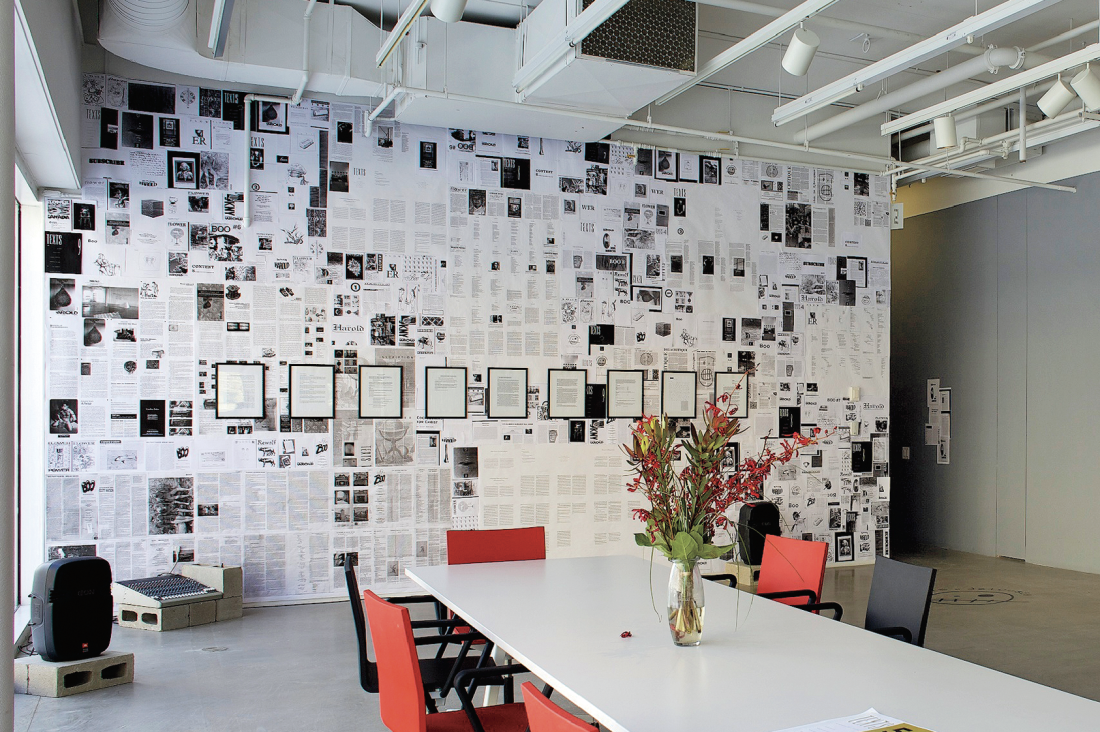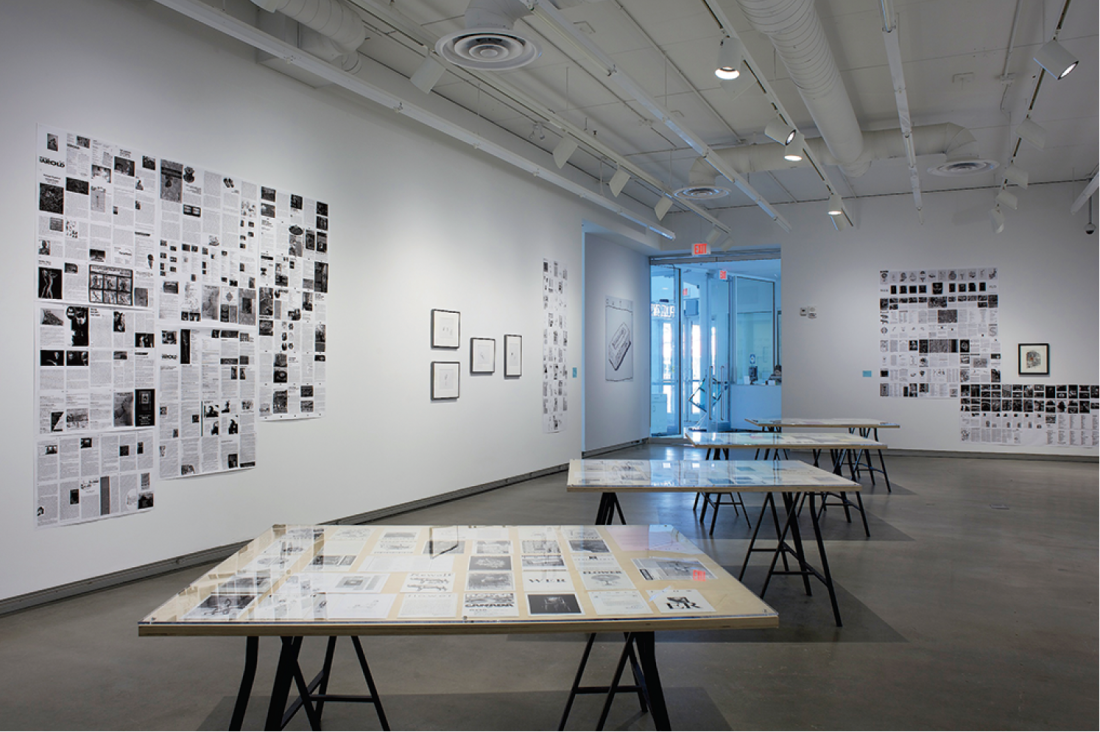“Yesterday Was Once Tomorrow (or, A Brick Is A Tool)”
I really fucking miss my dead friends. It is strange to write this in relationship to an exhibition of art magazines, but such were my feelings after viewing “Yesterday was Once Tomorrow (or, A Brick is a Tool)” curated by Kegan McFadden at the Plug In Institute of Contemporary Art. The show, which powerfully evokes the insurgent and marginal creative landscape of Canadian contemporary art—now 20-years past—made me think of folks with whom I explored some of the terrain mapped out in the pages of these periodicals. I realize this reaction is a fit of nostalgic anger on my part, but this remarkable show, highlighting five Canadian art magazines from the 1990s, nonetheless recalls both the intersectional conditions of possibility within alternative culture of the period, and the reality of genuine loss in terms of people, time and opportunity that has impoverished us in the years since. As curator McFadden clearly realizes, archival research has power, and can itself be a brick, a tool, to be wielded against the institutional and bureaucratic conformity of contemporary art institutions in Canada.
The exhibition is both a retrospective and a visual unpacking of five art periodicals: Boo (Vancouver), Cube (Montreal), Flower (Toronto), The Harold (Winnipeg) and Texts (Calgary). All were magazines with relatively short runs that emerged in the early 1990s and closed shop before the decade’s end. The periodicals themselves have an artefact quality to them, despite being objects from a relatively recent past. This is reinforced by the presentation of the magazines under glass on five large tables in the centre of the main gallery space. These tables display multiple issues of the publications, in often densely packed and overlapping arrangements that show the magazines’ covers, inside pages and recollections from former principles as textual fields. Here, the sheer diversity of design, font, layout and graphic choices both within and between the publications is made especially visible and apparent. Magazines such as The Harold mutate from a simple publication, with all the design panache of a condominium newsletter, to a more stylized and ambitious art periodical.
In addition to the tables McFadden has mounted the magazines dramatically on gallery walls. Spread over the Plug In’s three exhibition rooms are selective reproductions of pages, graphics and design elements, all interspersed among a number of works by contemporary artists featured in issues of each of the magazines. The show itself is an emblematic example of the archival turn within contemporary art, at least in the sense that McFadden’s exhibition seeks to transform documents—contemporary art periodicals—into a form of visual art and not simply mine these texts for a synthetic historical display. Such so-called evidentiary aesthetics places the production of knowledge at the centre of its visual practice. That McFadden as curator would adopt such an integrated approach should come as no surprise in that he is an exceptionally fine artist in his own right, and this exhibition is in and of itself an art installation as much as it is a curated show. His literal unpacking of archives is thus negotiated by an artistic practice that both strives to honour the content of the text but also treats the publications as found objects to be turned out, broken apart and then reconstituted as posters, decals and wallpaper.

Installation view, “Yesterday was Once Tomorrow (or, A Brick is a Tool),” 2015, Plug In Institute of Contemporary Art, Winnipeg. All images courtesy: Plug In ICA, Winnipeg.
The significance of these periodicals should not be diminished by their relatively short publishing lives. All the publications were part of an alternative moment of art writing and publishing that for all intents and purposes has vanished. This is not to say that improvised, do-it-yourself, in-house publications no longer exist—they do, in abundance. Rather, the radical shift in digital media technologies since the mid-1990s consigns these publications to a very different epoch. Making a zine or kitchen table magazine today is a bit like listening to vinyl records—something one does because of its aesthetic and affective sensibilities, not because it is the only way to listen to an album. This of course was not the case in the mid-1990s, when email was still just emerging and Facebook founder Mark Zuckerberg was in elementary school. These magazines illustrate the efforts by artists and critics to reach out and communicate in a broader sense beyond the informal and individuated local networks of dialogue. That text itself is productive and critical to the creation, in the Habermasian sense, of an alternative public sphere. That is the effort by artists and cultural critics to create public discourse and commentary around art that is often outside or marginal to the existing traditions, forums and established media venues, something that blogs, Twitter and no end of other social media platforms facilitate but nonetheless fail to affectively replicate.
It is not merely the technologies of production that mark the magazines as exceptional; it is also their content, particularly the art and artists that animate their pages. McFadden complements his expansive poster-like fields of the magazines with selective works of art from the period that were themselves featured in the pages of periodicals. Many of the pieces on display, with a few exceptions, are smaller, two-dimensional works on paper. These have a genuine informality about them, almost suggesting they were torn from an artist’s sketchbook before being framed and placed on a gallery wall. What is more significant is that a number of works selected for display engage aspects of gender, sexuality, the body and the contentious representational politics of transgressive desire and expression.
The most obvious example of this focus on sexuality relates to Flower’s coverage of artist Eli Langer’s infamous first solo show at Toronto’s Mercer Union Gallery in late 1993 that resulted in one of the decade’s most prominent criminal trials on censorship, artistic express, obscenity and harm. Flower not only “covered” the raid and the subsequent trial, but reprinted articles on Langer and his trial that appeared in mainstream and alternative presses. In this sense the editors of Flower were themselves taking on the archival role of collecting and preserving the textual record generated by this case. The Plug In exhibition includes four of the seized drawings from Langer’s show at Mercer. Unarguably provocative and contentious, the works are a clear reminder of how representations of sexual abuse can themselves be read, interpreted, and even become implicated in exploitative asymmetries.
The critical importance of bio-politics, the seizure of books by Canada Border Services Agency, and intense debates around sexual expression generated by the so-called sex wars are visible in a number of other works in the show. These include a selection of “Tom Girl” drawings by queercore and lo-fi pioneer GB Jones, which were featured in Vancouver-based Boo magazine. These figurative drawings on paper reimagine the gay BDSM erotica of artist Tom of Finland as they feature an array of young, fit, leather-clad and seemingly white, butch/femme punk women. Similarly, artist Shary Boyle’s drawing of an anthropomorphic dog/man having sex with a woman in an armchair recasts the heteronormative and misogynistic tropes of commercial pornography. In a less explicit, and arguably more overtly feminist vein, is Lori Weidenhammer’s wonderful video Don Juan Envy from 1996. This retelling of the legendary lover, Don Juan, utilizes a drag king sensibility in its insistence on gender diversity and transgressiveness as generative of an alternative erotic possibility.

Installation view, “Yesterday was Once Tomorrow (or, A Brick is a Tool),” 2015, Plug In Institute of Contemporary Art, Winnipeg.
Though the show highlights works by a few artists who were just emerging and establishing their careers in the 1990s, it would be a mistake to see these magazines as by and about people in their 20s. Indeed, one of the first pieces in the exhibition is a delicate collage by Toronto artist John Massey, of an orange and red flower on what appears to be a memento mori engraving of a cherub cloaking a skeletal Death. McFadden’s choice of this work not only underscores the sense of things past in terms of the magazines, but also the larger art scene of the period, and in no small part the fact that these publications were being produced at the height of the AIDS crisis in Canada.
Reading the magazines you are confronted by loss, particularly as you encounter articles on iconic people of the era, such as American novelist Kathy Acker. In her virtuoso critique of the literal displacement, demise and the eradication of artistic culture and space, The Gentrification of the Mind: Witness to a Lost Imagination, writer Sarah Schulman points to Acker as an emblematic figure of the period, critically influential to an array of artistic movements, whose reputation nonetheless has suffered since her death in 1997. During the late 1980s and early 1990s Acker was at the forefront of literary and aesthetic sensibility, an inspiration for artists such as Kathleen Hanna, and harbinger of the Riot Grrrl movement of feminist punk rock and cultural creativity. Fifteen years after her passing, Schulman wrote, “Her death, in the midst of the AIDS crisis, was another elimination of free space, another shrinking of the community of non-corporate thinking. Another victory for the power of homogeneity.” Reading Schulman’s thoughts on Acker I can’t help but expand her observations, and lament the erosion of the cultural terrain explored in the five magazines in this exhibition.
In focusing on magazines from the early and mid 1990s, McFadden is making a larger point about the protean state of contemporary art, one which invites an implicit comparison between the yesterday of the exhibit and now. In highlighting politically charged and risky work, McFadden subtly points to the limits, neutrality and structuring confines of contemporary galleries and museums. The inclusion of four playful ink drawings by Jake Kosciuk, from his 1996 solo show at Plug In, vividly makes this point. Today, would any established contemporary gallery in Canada give a 22-year-old artist, who had yet to even graduate from art school, their first solo show? Seems astonishingly unlikely. Times have changed considerably over the last two decades; the professionalization of artists, an increased focus on credentials and shifts in the financial architecture of grant funding make the world of “Yesterday Was Once Tomorrow” seem even more remote. In this sense, McFadden’s sophisticated exhibition is a form of immanent critique—as much as it is an homage or an act of historical recovery—one which all of us who are part of the contemporary art world need to consider and heed. ❚
“Yesterday was Once Tomorrow (or, A Brick is a Tool)” was exhibited at Plug In Institute of Contemporary Art, Winnipeg, from February 7 to May 24, 2015. It will be on exhibition at Artexte, Montreal, in the Fall of 2015.
David S Churchill is a queer cultural critic, sometime curator and Associate Professor of US History at the University of Manitoba.

